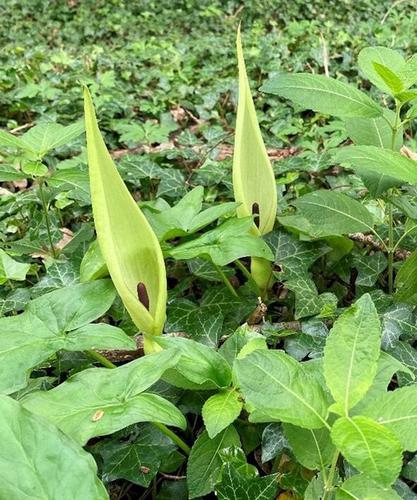当前位置:
X-MOL 学术
›
Appl. Veg. Sci.
›
论文详情
Our official English website, www.x-mol.net, welcomes your
feedback! (Note: you will need to create a separate account there.)
Relative contribution of ancient woodland indicator and non‐indicator species to herb layer distinctiveness in ancient semi‐natural, ancient replanted, and recent woodland.
Applied Vegetation Science ( IF 2.0 ) Pub Date : 2020-06-22 , DOI: 10.1111/avsc.12501 Kelly A. Swallow 1 , Matt J. Wood 2 , Anne E. Goodenough 2
Applied Vegetation Science ( IF 2.0 ) Pub Date : 2020-06-22 , DOI: 10.1111/avsc.12501 Kelly A. Swallow 1 , Matt J. Wood 2 , Anne E. Goodenough 2
Affiliation

|
Questions: The floristic distinctiveness of ancient woodland relative to recent woodland is commonly measured by Ancient Woodland Indicator (AWI) species richness. However, focusing on a pre-defined subset of species means that wider community-level differences may be overlooked. Can ancient semi-natural, ancient replanted, and recent woodland herb layer communities be distinguished by alpha, beta, and gamma diversity? How are any differences partitioned across AWI and non-AWI species communities? Location: Cotswolds, South-West UK. Methods: To quantify AWI and non-AWI responses to stand history in ancient semi-natural, ancient replanted, and recent woodland, we conducted floristic surveys of 45 sites. Using a modelling approach, we tested the relative and additive contribution of alpha scale AWI and non-AWI species richness to woodland distinctiveness. Ordination was applied to analyse beta species composition distinctiveness, and multilevel pattern analysis was used to examine which species were significant contributors to gamma scale richness differences. Results: AWI species richness models significantly distinguished ancient semi-natural woodland from both ancient replanted and recent woodland at the alpha scale. For the classification of ancient semi-natural woodland and recent woodland, the hierarchical inclusion of non-AWI alpha richness resulted in a superior and more significant model. AWI gamma richness was numerically similar for all three woodland categories, whereas non-AWI was more varied. AWI and non-AWI species composition showed significant beta diversity differences among all woodland types, with six species being significant drivers of differences. Conclusions: Our results have revealed previously undetected complexity in the contributions of AWI and non-AWI species to floristic distinctiveness of ancient woodland. In addition to traditional AWI species, the non-AWI assemblage also exhibited a sensitivity to habitat continuity that: (a) adds weight to the argument that ancient woodland is floristically distinct from recent woodland; and (b) provides a useful measure of success for ancient replanted woodland restoration.
中文翻译:

古林地指示剂和非指示剂物种对古半自然、古改植和近代林地草本层独特性的相对贡献。
问题:古代林地相对于近代林地的植物区系特征通常通过古代林地指标 (AWI) 物种丰富度来衡量。然而,专注于预先定义的物种子集意味着可能会忽略更广泛的社区级别差异。古代半自然、古代再植和近代林地草本层群落能否通过 alpha、beta 和 gamma 多样性进行区分?AWI 和非 AWI 物种群落之间的差异如何划分?地点:英国西南部科茨沃尔德。方法:为了量化 AWI 和非 AWI 对古代半自然、古代再植和近代林地林分历史的反应,我们对 45 个地点进行了植物区系调查。使用建模方法,我们测试了 alpha 尺度 AWI 和非 AWI 物种丰富度对林地独特性的相对和附加贡献。排序用于分析β物种组成的独特性,并使用多级模式分析来检查哪些物种是伽马尺度丰富度差异的显着贡献者。结果:AWI 物种丰富度模型在 alpha 尺度上显着区分了古代半天然林地与古代再植林地和近代林地。对于古代半自然林地和近代林地的分类,非 AWI alpha 丰富度的分层包含导致了一个更好和更显着的模型。所有三个林地类别的 AWI 伽马丰富度在数值上相似,而非 AWI 则差异更大。AWI 和非 AWI 物种组成在所有林地类型之间显示出显着的 beta 多样性差异,其中六个物种是差异的显着驱动因素。结论:我们的结果揭示了 AWI 和非 AWI 物种对古林地植物区系独特性的贡献的先前未被发现的复杂性。除了传统的 AWI 物种外,非 AWI 组合还表现出对栖息地连续性的敏感性:(a) 增加了古代林地与近代林地在植物区系上不同的论点;(b) 为古代重新种植的林地恢复提供了一个有用的衡量标准。我们的研究结果揭示了 AWI 和非 AWI 物种对古代林地植物区系独特性的贡献中以前未被发现的复杂性。除了传统的 AWI 物种外,非 AWI 组合还表现出对栖息地连续性的敏感性:(a) 增加了古代林地与近代林地在植物区系上不同的论点;(b) 为古代重新种植的林地恢复提供了一个有用的衡量标准。我们的研究结果揭示了 AWI 和非 AWI 物种对古代林地植物区系独特性的贡献中以前未被发现的复杂性。除了传统的 AWI 物种外,非 AWI 组合还表现出对栖息地连续性的敏感性:(a) 增加了古代林地与近代林地在植物区系上不同的论点;(b) 为古代重新种植的林地恢复提供了一个有用的衡量标准。
更新日期:2020-06-22
中文翻译:

古林地指示剂和非指示剂物种对古半自然、古改植和近代林地草本层独特性的相对贡献。
问题:古代林地相对于近代林地的植物区系特征通常通过古代林地指标 (AWI) 物种丰富度来衡量。然而,专注于预先定义的物种子集意味着可能会忽略更广泛的社区级别差异。古代半自然、古代再植和近代林地草本层群落能否通过 alpha、beta 和 gamma 多样性进行区分?AWI 和非 AWI 物种群落之间的差异如何划分?地点:英国西南部科茨沃尔德。方法:为了量化 AWI 和非 AWI 对古代半自然、古代再植和近代林地林分历史的反应,我们对 45 个地点进行了植物区系调查。使用建模方法,我们测试了 alpha 尺度 AWI 和非 AWI 物种丰富度对林地独特性的相对和附加贡献。排序用于分析β物种组成的独特性,并使用多级模式分析来检查哪些物种是伽马尺度丰富度差异的显着贡献者。结果:AWI 物种丰富度模型在 alpha 尺度上显着区分了古代半天然林地与古代再植林地和近代林地。对于古代半自然林地和近代林地的分类,非 AWI alpha 丰富度的分层包含导致了一个更好和更显着的模型。所有三个林地类别的 AWI 伽马丰富度在数值上相似,而非 AWI 则差异更大。AWI 和非 AWI 物种组成在所有林地类型之间显示出显着的 beta 多样性差异,其中六个物种是差异的显着驱动因素。结论:我们的结果揭示了 AWI 和非 AWI 物种对古林地植物区系独特性的贡献的先前未被发现的复杂性。除了传统的 AWI 物种外,非 AWI 组合还表现出对栖息地连续性的敏感性:(a) 增加了古代林地与近代林地在植物区系上不同的论点;(b) 为古代重新种植的林地恢复提供了一个有用的衡量标准。我们的研究结果揭示了 AWI 和非 AWI 物种对古代林地植物区系独特性的贡献中以前未被发现的复杂性。除了传统的 AWI 物种外,非 AWI 组合还表现出对栖息地连续性的敏感性:(a) 增加了古代林地与近代林地在植物区系上不同的论点;(b) 为古代重新种植的林地恢复提供了一个有用的衡量标准。我们的研究结果揭示了 AWI 和非 AWI 物种对古代林地植物区系独特性的贡献中以前未被发现的复杂性。除了传统的 AWI 物种外,非 AWI 组合还表现出对栖息地连续性的敏感性:(a) 增加了古代林地与近代林地在植物区系上不同的论点;(b) 为古代重新种植的林地恢复提供了一个有用的衡量标准。







































 京公网安备 11010802027423号
京公网安备 11010802027423号